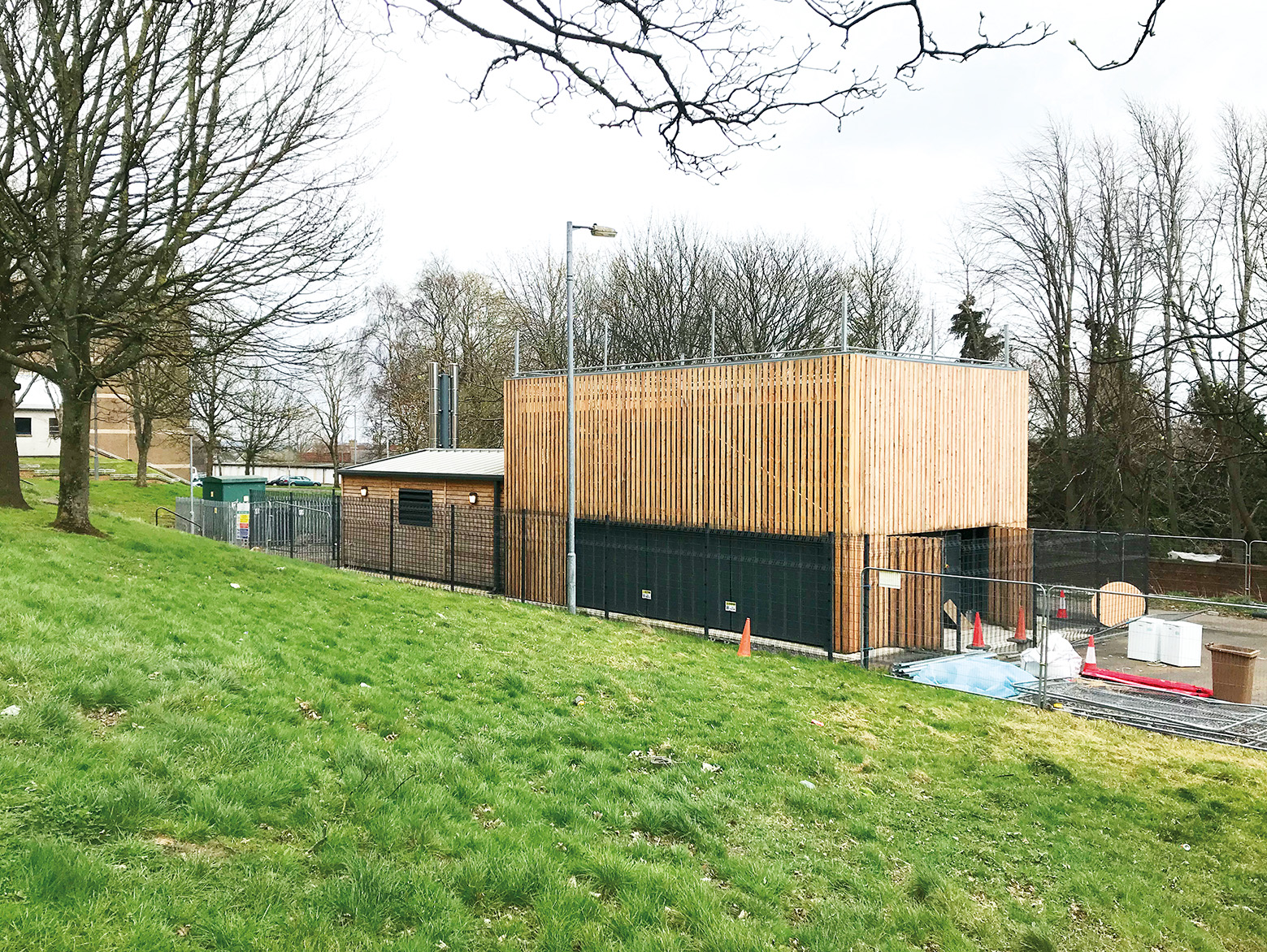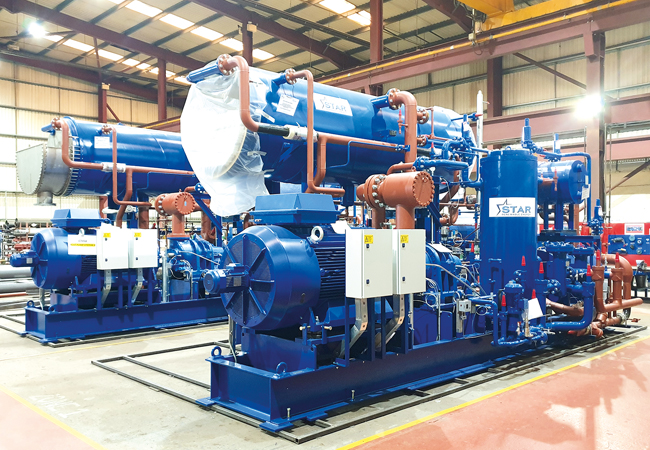
‘I never imagined a core part of my life would be influenced by throwing dog biscuits into a river during a school geography project,’ says David Pearson, director of Star Renewable Energy, the division of Star Refrigeration focused on the design of large heat pump systems for district heating.
‘Dog biscuits are cheap, they float, and if you measure the time it takes a floating biscuit to travel 10 metres – and divide that by 10 – you’ll get the river’s flow velocity in metres per second,’ he says. Knowing the river’s velocity and cross-section is fundamental to calculating how much heat is available to be captured by a water source heat pump, which is Pearson’s interest.
It is this knowledge, acquired from his geography class, that has led Pearson to the conclusion that large heat pump installations could fundamentally change the way heat is generated in the UK – and, critically, help to decarbonise the existing energy-inefficient building stock in cities.
‘Our cities are typically located on larger rivers, where gravity drains the upper reaches, delivering solar thermal energy right to where we need it most,’ he says. ‘We won’t win the decarbonisation battle with new houses. It’s the old stuff that is the challenge, and it’s too tricky to decarbonise many of these buildings on an individual basis. So the best way is to take a district heating system into the centre of a city and use that to supply buildings with low carbon heat.’
For Pearson, the obvious source of low carbon heat for cities are their rivers. ‘By our rough calculation, for example, there is about eight times as much heat in the river Clyde as you would need to heat Glasgow’s entire city centre.’
“To me, act faster means deploy what we know works: don’t dream of unicorns”
Pearson has worked at Star Refrigeration for 20 years. The business was started by his father and two colleagues in Glasgow, in 1970, to specialise in commercial and industrial refrigeration, and it is still based in the city. His father, who is nearly 88, is also still involved, but Pearson’s older brother Andy [not the author of this article] is now group managing director. Although the business is privately owned, there are more than 300 shareholders, mainly past and present staff and their families.
Independence and long-term thinking are of paramount importance, says Pearson, who graduated from university with a degree in engineering with business management and European studies. He worked for another Glasgow-based engineering business, Howden, before being asked to join Star to help design refrigeration systems for ice rinks and cold-storage projects. After a four-year spell at a spiral and tunnel freezer acquisition, Starfrost, in Lowestoft, he returned to Star’s Glasgow headquarters to work on ‘where next?’.
‘The UK is a solid market, but not growing,’ Pearson says. ‘Sustainable heating caught our eye, and high-temperature heat pumps draw the same skills as industrial refrigeration, so was an obvious match.’
One of the big schemes he subsequently worked on was proof of this – a £25m upgrade of the district heating system in Drammen, Norway. This innovative project uses a water source heat pump to take low-grade heat from the adjacent fjord and turn it into high-grade heat to supply heating for the 60,000-strong community. As well as air quality, the key driver was to move from biomass and gas.
The fact that Star’s heat pump solution uses only three systems of 780kg of ammonia as the refrigerant was one of the reasons the company was awarded the contract, says Pearson. ‘We won the job ahead of a company that had promoted a solution using up to 7,000kg of R134a, an HCFC with a global warming potential (GWP) 1,430 times that of carbon dioxide.’
He adds that it is not unreasonable to expect a large refrigerant system, such as the one at Drammen, to leak about 1% a year: ‘70kg of R134a at a GWP of 1,430 is a big number – equivalent in GWP to driving 800,000km a year. Whereas, by using ammonia, our GWP is the fat end of nothing. Ammonia is also about 25% more efficient, so consumes far less electricity, the primary operational cost.’
Working with ammonia
Delivering heat at 90°C using an ammonia-based heat pump is not without its challenges. According to Pearson, the International Energy Agency acknowledged the potential of ammonia as a refrigerant in 2007, but said it was not possible for systems operating above 70°C because they thought the pressure needed would be too high for commercial systems. Not so for Star, with its compressor partner Vilter (now owned by Emerson). It had experience of using CO2 as a refrigerant at pressures up to 110bar, so the 65bar working pressure of the Drammen heat pump was well within its capabilities if a compressor was available.
Pearson says Star has always worked with ammonia because such refrigerant systems are the most energy efficient and environmentally friendly. ‘If you look at the lifetime costs of a refrigeration plant or heat pump, about 70% of the cost is down to electricity consumed running the system, 15% is capital cost and 15% is the cost of maintenance over a 20-odd-year life,’ he says.
‘That said, we’ve built large projects using propane, CO2 and HFCs – whatever refrigerant the client wants we’ll consider using it in the best possible way.’
It is not the ammonia refrigerant that makes the Drammen district heating system unique. ‘As far as I’m aware, it is still the only large-scale 90°C district heat pump in the world,’ says Pearson. He admits there were some elements of the Drammen installation that were ‘a wee bit sticky’, but he points out that ‘innovating is not without its challenges’ and says Star ‘stuck with it and got it right’.
The ammonia-based heat pumps are now delivering 85% of Drammen’s near-70GWh of heat each year. Gas is only for top-up on the coldest days.
At about the same time as the Drammen heat pump was coming on line, the UK government was talking about the need to decarbonise heat as a consequence of the EU’s renewable energy sources directive. Star saw an opportunity to use its experience of Drammen to grow its business. ‘We’d decided that a big part of the business going forward would be in heating as well as cooling,’ says Pearson.
However, biomass and gas combined heat and power (CHP) – as well as a reluctance to change – left Star frustrated at the slow uptake. So, in 2013, it set up Star Renewable Energy, a new division to focus specifically on big heat pump projects for district heating systems.
‘We understand heat exchangers and compressors and thermodynamics; if there is going to be a trend for heat pumps, then we should be part of that,’ Pearson says. ‘I now lead that business unit, which is able to draw on all the refrigeration skills we already have at Star, but for a totally different application.’
Hillpark, Glasgow – a high-temperature air source heat pump
Client: GHA Wheatley Group
Refrigerant: R134a
Capacity: 400kW
Temperature: 62°C/40°C
Supported by the Scottish government
An air source heat pump providing heat at 62°C (40°C return) is being used to provide 351 homes with low carbon heat. The relatively high water temperatures enable conventional radiators to be used to heat the homes.
The Hillpark Drive estate in south Glasgow comprises eight apartment blocks, built in the 1970s, and is operated by Glasgow Housing Association, part of the GHA Wheatley Group. It secured a £2.5m grant from the Scottish government’s Local Energy Challenge Fund, plus money from Glasgow City Council, to carry out a £5m project to: upgrade the estate’s heating system; replace the inefficient and impractical electric storage heaters to provide affordable heating; and reduce carbon emissions.
The solution, developed by project consultants WSP/Parsons Brinckerhoff, is based on an air source heat pump providing heat for a new district heating system. Gas is used as a top-up/back-up energy source. The linear layout of the eight blocks lent itself to a district heating solution. A piped central flow and return spine was formed from Rehau’s Rauthermex polymer pre-insulated pipework, with heat taken off for individual blocks.
The heat pump has in-built control systems for remote monitoring, to ensure optimum efficiency is maintained. A single energy centre houses the 8m-long heat pump – which means only one device has to be maintained – and it is expected to have a service life of more than 20 years.

Wooden building adjacent to Hillpark high-rise blocks housing Star’s air source heat pump
Pearson is passionate – fanatical even – about the potential for heat pumps to replace burning fossil fuels, such as natural gas, to provide heat. ‘Heating is about 50% of the energy consumed in the UK, so we have this challenge of how to do heating without burning gas and biomass – and that’s where large heat pump solutions come into their own,’ he says.
‘Although not originally a strategic driver, we have observed the growing emphasis on air quality. Drammen still shows us a fantastic outcome in this regard, with 85% lower nitrogen oxide (NOx) emissions, the gases now attributed to lung, heart and brain disorders, but largely invisible. Although largely attributed to transport in cities, some studies have suggested 40% is actually from gas boilers and other gas devices, such as CHP.’
Pearson adds: ‘The problem with replacing gas boilers with heat pumps on a piecemeal basis is that gas heating systems are, generally, designed to operate at 82°C flow, 71°C return temperature. ‘If you want to replace that system with a heat pump, you cannot turn up with a domestic unit that only provides heat at 45°C,’ he says.
Star has three systems nearing completion in 2019. The Clydebank river-source scheme will provide heat at 80°C, the Hillpark air source heat pump scheme at 62°C, while the ground source heat pump serving the renovated old Post Office at Islington Square provides heat at 65°C. ‘The residents won’t be aware of the heat pumps, but they will enjoy cleaner local air with less gas being burnt.’

Twin water source heat pumps to be installed at Queens Quay
Queens Quay – a water source heat pump on the River Clyde
Client: Vital Energi
Refrigerant: Ammonia
Capacity: 5.2MW
Temperature: 80°C/60°C, then 75°C/45°C
Supported by the Scottish Government Low Carbon Infrastructure Investment Programme
Scotland’s first major district heating network served by a river-source heat pump is currently being installed under West Dunbartonshire Council’s £250m regeneration scheme for the Clydebank area. This residential-led, 23-hectare development, on the site of the former John Brown shipyard, includes the addition of new homes and business premises.
The scheme’s location, on the banks of the river Clyde, made it the perfect application for a water-source heat pump. The 5.2MW heat pump will extract heat from the river and use it to supply the district heating system. The heat pump has been designed to run on an open-loop design, with water abstracted from the river in direct contact with the evaporator heat exchanger.
The £15m district heating system will connect to existing buildings in the area, the majority of which are currently heated by gas and generally run at 80°C flow/70°C return.
Initially, the temperature of heating mains will be 80°C flow, 60°C return. However, to improve the heat pump’s efficiency, the temperature of the heating mains will be lowered to 75°C/45°C over time. New developments are being built with heating systems designed to operate at 75°C/45°C, while the heating systems in existing buildings will be adapted to enable them to operate effectively at these temperatures.
Properties are connected to the district heating network via a heat interface unit.
Does he see a time when cities will have both district heating and cooling? ‘If you want district cooling and heating systems, you could have four-pipes going into the buildings or a two-pipe ambient loop system and a heat pump in each building,’ he says.
‘A heat pump in each building would be tricky if aiming for close to 80°C and, if you’ve got dozens of buildings on a network, they will each require a heat pump sized for their individual max demand – whereas, if you’ve got district heating and separate cooling systems, the central heat pump will be sized for the aggregate demand, which could be 50-60% smaller. And, because they are centralised, they’ll be easy to turn off very quickly if the grid gets stressed – a very valuable technique, far preferable to running auxiliary diesel peaking plant.
‘We can also force-run and store heat, which is far more sensible than curtailment of wind farms, and turns the surplus electricity into three or more units of heat.’
Pearson has taken his fixation with heat pumps home. ‘As part of renovations to my house, I’ll probably deploy a ground source heat pump – but it’s a monstrous amount of money when a gas boiler would work fine,’ he says. ‘But gas will eventually fade and any provision of hydrogen is predicted to be three or more times the cost of gas currently.’
“Pearson is passionate – fanatical even – about the potential for heat pumps to replace burning fossil fuels, such as natural gas, to provide heat”
The late Professor Sir David MacKay, the government’s chief scientific officer, was a huge influence on Pearson’s thinking, encouraging critical thought of populist ideas in his book Sustainability without hot air.
‘He’d question where hydrogen was going to come from, how much it would cost, whether it would require additional methane imports, and how dependent it would be on as yet unproven at-scale solutions, such as carbon capture,’ says Pearson.
‘If I’ve heard anything from the upsurge in thinking from [Swedish schoolgirl] Greta Thunberg – who initiated the school “strike for climate change” movement in November 2018 – it is “act faster”, and that, to me, means deploy what we know works: don’t dream of unicorns.
‘I hope they start encouraging a move forward from what we know is the major component of the problem – “burning gas” for the rather simplistic need of heat.’
